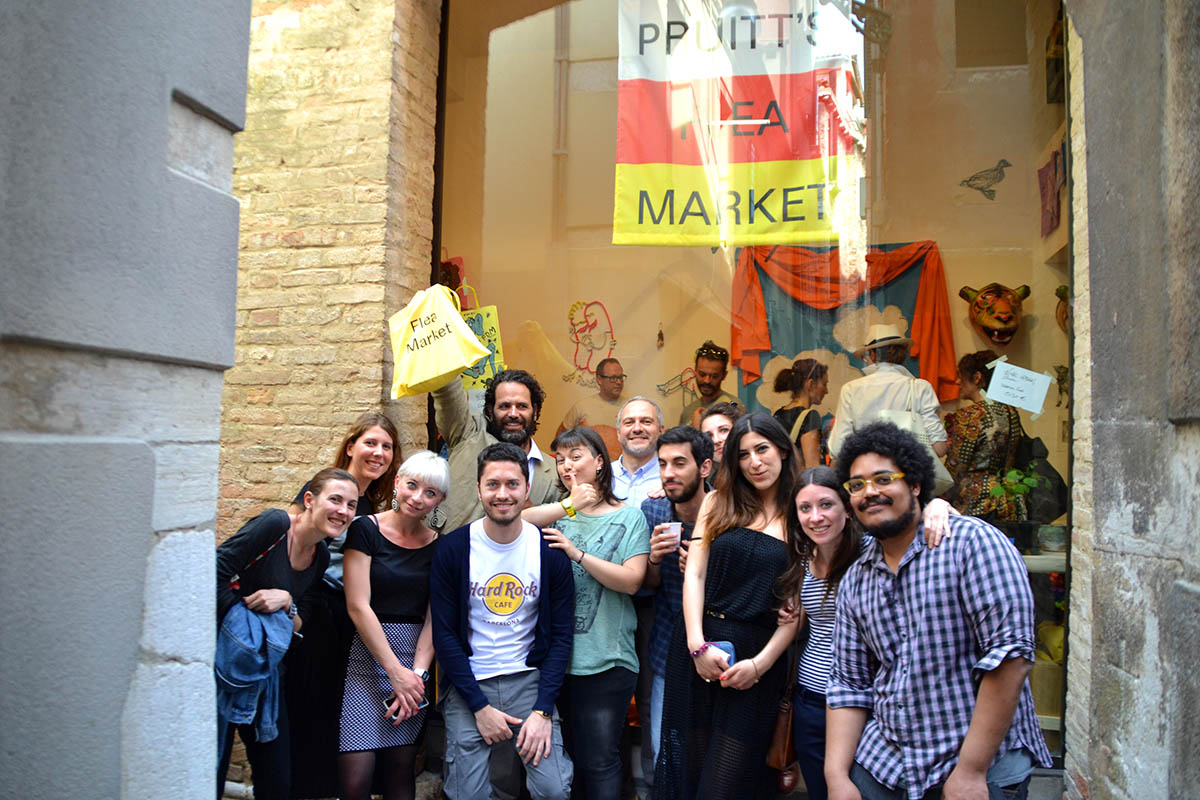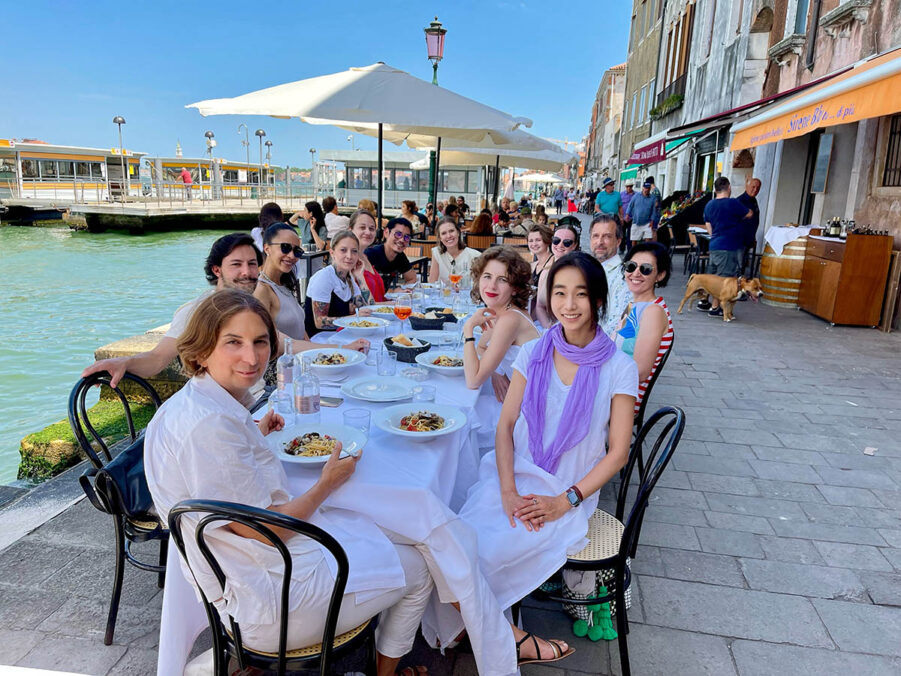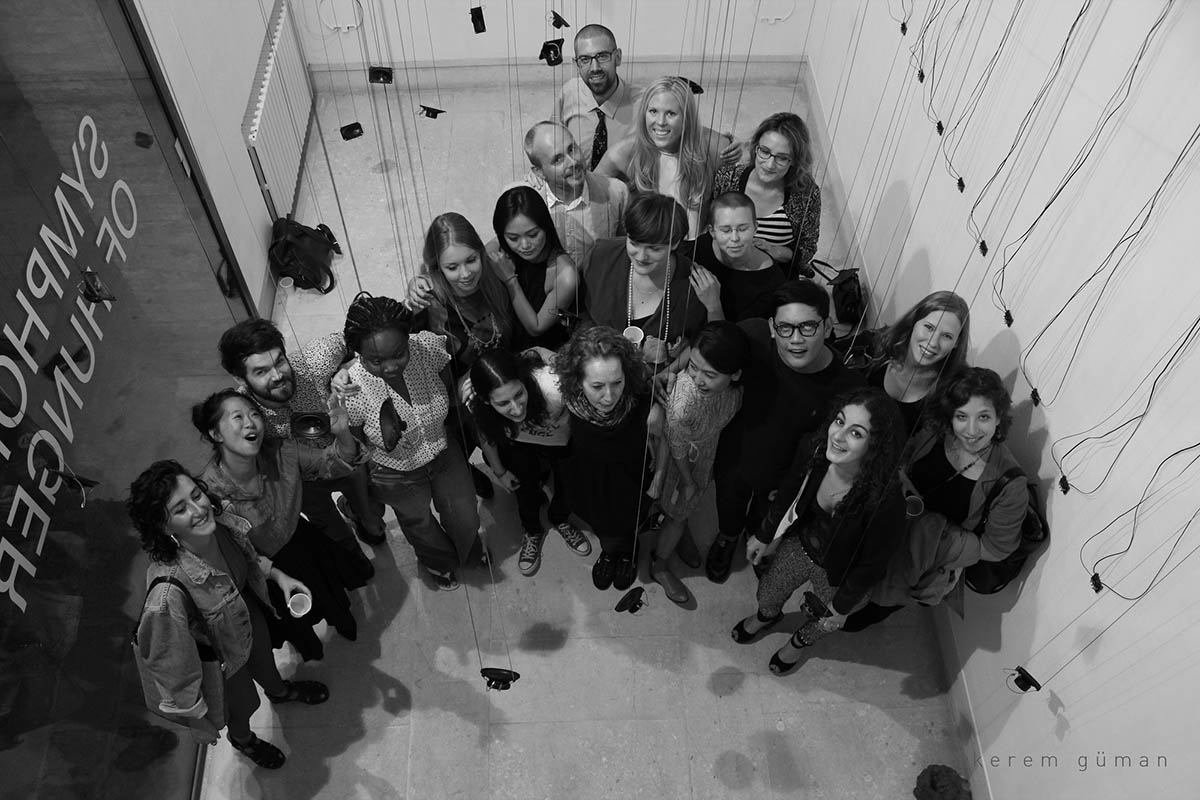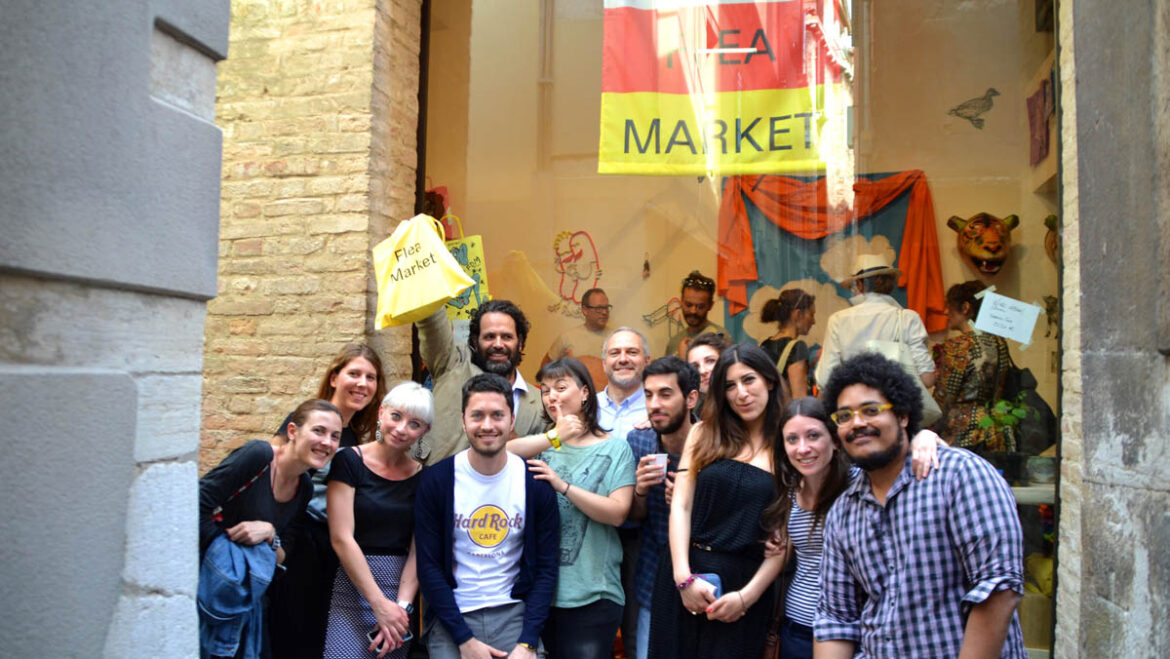
The school provides a unique environment for cultivating curatorial skills, attracting students and curators from Italy and around the world. We spoke with Aurora Fonda, the founder of the school.
Erka Shalari: Aurora, tell us something about your journey. How did you come to Venice, what inspired you to establish the School for Curatorial Studies, and how did the idea for the A plus A Gallery originate?
I was born in Slovenia and came to Venice to study Art History. I continued my studies here until my PhD, which I earned in Padua while continuing to live in Venice. Even before I finished university, I started curating exhibitions of emerging artists with a curator friend while attending the Fabrica residency in Treviso. This marked the beginning of my career as an independent curator, organizing exchanges between the Slovenian and Italian cultural scenes. During those years, I had the opportunity to work with artists such as Janis Kounellis and Enzo Cucchi and to curate exhibitions of historical artists such as Joseph Beuys and Andy Warhol, who were receiving great interest in Slovenia at that time. In 2001 and 2015, I was appointed curator of the Slovenian Pavilion at the Venice Biennale, and in 2003, I became the Director of the A plus A Gallery, which at the time was run by the Ministry of Culture functioning as the venue of the Slovenian Pavilion for the Venice Biennale.
The gallery operated as a non-profit space and, during the months when the Biennale was not in session, we showcased both Slovenian and Venetian artists. In those years, the gallery played an important role in the city’s cultural life, becoming a meeting point where many artists who were based in Venice had their debut exhibitions.
When I think of that time, I can’t even count how many events, small exhibitions, performances, sound events, and conferences we had organised! While carrying out the program of the Slovenian Pavilion, I had the opportunity to host several university students for internships, noticing in them a great curiosity and interest in deepening practical and theoretical aspects of curating, areas that the university system at the time did not adequately address. As a result, I came up with the idea to create an independent program that could provide the tools to approach the profession of the curator. I founded the School for Curatorial Studies Venice, one of the first institutions in Italy to offer this kind of training.

In 2014, when the Slovenian Ministry of Culture decided to get a venue in Arsenale, where most countries have a space during the Biennale, my partner Sandro Pignotti and I decided to keep the gallery and convert it into an independent space. We are now a private gallery with a strong curatorial imprint supporting projects with meaningful concepts; we actively foster the research and creativity of the artists we invite, even when it entails taking risks in the market. The gallery is indeed a space for experimentation and exchange where many artists over the years have had their first solo exhibition or the possibility to showcase experimental projects in Venice, continuing then their journey in important galleries or institutions.

The programme involves international artists without forgetting to include and promote the local artists who live in Venice that make this city worth visiting even in the months when the Biennale is not happening. This is briefly the history of the gallery and the School, which respectively celebrate 10 and 20 years of activity in 2024.
Erka Shalari: While scrolling through the early Instagram posts of the school, I was struck by the diverse range of lectures you’ve organized for your students; and pivotal figures in the art world—curators, galleries, and collectors. The first image I saw was of curator Luca Lo Pinto teaching. Can you share how the concept for your initial English courses came into being? Furthermore, from which field do the students come?
Initially, the course was structured as a short 3-week program in Italian, certainly not enough to approach the profession of the curator and deal with those aspects related to the realisation of an exhibition, such as confrontation with artists, promotion, organisation, and, of course, research. As a consequence, it came the necessity to structure a longer and more in-depth training offer, and at the moment the winter course in Italian has a duration of 5 months.
A few years after the foundation of the course, we started to receive several requests from international students and the need arose to also organise an international summer school with lessons in English, a very intensive course aimed at international students and professionals. The structure of both programs (winter and summer) is the same: lectures take place from Monday to Friday, from 9.30 am to 5.30 pm. Morning classes are devoted to theoretical lectures such as the history of curatorial practice and critical writing, while the afternoons are dedicated to visits to exhibitions and artists‘ studios. At the same time, we start working on a final exhibition. The group then turns into a real exhibition office; together with the students, we work on the concept, select the artists, and organise all the practical aspects.

If putting together an exhibition is challenging, it becomes even more so when 20 people with different backgrounds and ideas do it. Over the years, however, we have seen how what the students initially perceive as an obstacle becomes a moment of exchange and personal and professional growth. The groups of students are very heterogeneous both in terms of geographical and professional background. Some are already working as curators, others come from philosophy, design, photography, and law, and it is very unique for them, and for us, to be confronted with so many voices.
Sometimes, the students also have classes on Saturdays, or we give them work to do during the weekend. But that’s the life of the curator. Very often we cannot say, „I’m having a weekend off and I am not going to work in the evening“. There are certain moments when there is no rest – if you have to handle a list of artists, a text, or a concept of an exhibition, you just work until everything is over.
During the pandemic, we also decided to offer short online courses, reflecting carefully on how not to lose the participatory aspect of our school. We decided to focus on specific aspects and topics through short workshops that provide participants with the tools to then individually explore certain aspects and professions related to contemporary art. The groups are usually small so that an interpersonal relationship can be established even with the barrier of being online. Lessons are always live, and the lecturers we select are always available to engage with the students, creating an informal yet informative environment. In addition, each workshop, although online, includes a practical exercise so that there is also a moment of collective feedback and listening. In any case, all our training offers, from the long courses to the shortest workshops, have specificities.
In particular, with regard to the winter and summer courses, having the opportunity to curate an exhibition during the Venice Biennale helps to deal with a whole series of difficulties. What seems simple in any other city here is not! Curating an exhibition in Venice during the Biennale is complicated and has its peculiarities. Sometimes countries, artists and curators approach the Biennale without having the right tools, and so they often waste energy and money without achieving the desired results.
So, what could be some advice for curating effectively in Venice? What common mistakes could one avoid?
It is vital to have a budget and use it properly. But as long as there is a lot of competition for visibility, keep part of the money you have for a good press office. The other mistake that very often countries or even foundations are making, is presenting artist at the wrong stage of their career. The Venice Biennale can launch the career of an artist, but it can also extinguish it. Therefore, an artist needs to participate in the Biennale at the right moment. I am not saying that they all should be established artists, but they have to be in a very good position because if you don’t have galleries, collectors, and museums that are supporting and promoting you, then participating at the Venice Biennale is not bringing you much.
The school is also doing a selection process for joining the academy. How does it work?
We are receiving several applications, and the selection is often quite difficult. Applicants undergo an interview, we talk with them extensively before we accept them, because we look for motivated participants. Curating collectively is like playing in an orchestra, where everyone has a role. In order to make the exhibition happen, we need the contribution from everyone, because the final show is not just an exercise, but an exhibition opening to the public. We like to select students who come from different fields of knowledge and not only people who have studied art history or art management. We also have students who want to become or are already artists themselves. The most important thing for us is not only the study background and the professions but the real motivation and reasons why they want to dedicate their time to such an intensive course. We look for people who are willing to immerse themselves in the whole theoretical and practical process of exhibition making and who like to take part in this sort of adventure that we do together by conceiving the concept and doing the research.
For the final project of the course, we work with international artists. For our recent exhibition within the Italian program, a show on Censorship Double Take, we invited Jesse Darling, Simon Denny, Eva & Franco Mattes, Ahmet Ögüt, and Kasia Fudakowski. Names that are all well known to the contemporary world for a very critical and meaningful approach to art on the highest levels. When we curate a show we usually like to create a dialogue between more established artists and emerging artists we have been following for some time, as in the case of this exhibition Enej Gala, Barbara Prenka, and Monilola Olayemi Ilupeju.
The exhibition Double Take includes a research room, set up to complement the artworks and showcase the study process conducted by our students in the Historical Archive of the Venice Biennale. The space features newspaper articles, posters, videos, catalogues, and historical documents, including original photographs of the 1968 protests by Graziano Arici, which tell us about exemplary cases of censorship that have occurred throughout the history of the Biennale. For us, it is very important to work on the concept of the show and to involve artists who are really at the forefront in the production of art today.
Methods and dedication to research is something that we are definitely trying to pass on to our students and generations of young and future curators, as we are convinced that is a very important to create an intellectual core of an exhibition. There are so many poorly and careless curated exhibitions around the world often not even with a minimum of critical and curatorial dept. How many of them do we remember? Very often it is just a few of them. Young students who want to become curators must be given the chance to learn how to create a show that might leave a sign.
Has the role of the curator changed over time?
I think that the role of the curator is always fundamental, and it is also not a kind of job that could be taken away, replaced or even transformed in its core by some kind of fashion or some superficial understanding of technological, political, or socio-economical changes. Naturally, the role of the curator evolves over time. Some subjects are more relevant for one generation than for another, but at its core lies still the capacity to create narrations, a technique of meaning making and the capacity to emerge yourself in historical and philosophical research.
It is the capacity to find new forms of narrations or re-discovering old ones, the talent to make things visible that are right in front of our eyes, but they are often invisible because we do not notice them, and a good curatorial project takes us to look at them from a different perspective. All this is something that curators have been doing in the past as well. And in addition, there is not only one way of curating. You have several approaches, each of which is valid if it is well-made. It is not that Hans Ulrich Obrist’s approach is better than Harald Szeemann’s f.e. Recently we had a lecture at the course by Joel Valabrega from the MUDAM in Luxemburg. She is working with performance art, and she has an approach that relates pretty much to what she is actually working with – performative art. But also because curating becomes a kind of performative approach. There are different valid ways of curating. The most important thing is the research behind it. You feel it, when you enter an exhibition when it is well made.
You also mentioned Luca Lo Pinto before. Also, he has a particular approach to curating. What he has done in the museum in Rome is just incredible. He found himself, which is happening quite often, dealing with important architects who are building museums that are often not so functional, like in the case of MACRO by Odile Decq. The building is, in certain parts, made of little rooms, and each room is detached from the other. How do you do a narration of an exhibition in such a space? He had the idea, which is somehow related also to his history, as a publisher and founder of Nero magazine, to divide the museum spaces into different chapters like in a book. I think he has done a fantastic job, a good idea, that solved an architectonical precondition that was difficult to solve. This is something that a curator must have – the capacity to find a solution to transform an apparent disadvantage into an advantage. This is what I tell my students!
You mentioned that curating becomes a performative approach in itself. Could you elaborate on this idea?
The curator’s work is similar to an orchestra director, and this is the performance aspect of it. A curator has to be able to organise and get the maximum by playing different instruments or directing different professions to create a harmonic result. This applies especially when you have to do with a larger group show in a museum. And this orchestral performance can also change. For example, when you are curating a solo show. In this case, you are playing a score that still involves different professions but that on the artist side involves only one person who you relate to, and this can change the whole sound.
When you work with artists on a project, it is possible to create a synergy that enriches the artist, the curator and the visitor, especially when you work on an exhibition conceived for a space.
We also had as a guest of the School Chiara Bertola, who is now the director of GAM in Turin, and she was running for thirty years a contemporary art programme at the Querini Stampalia Foundation in Venice, which is an amazing place but also a challenging venue because you have to consider also the historical collection. In Querini Stampalia you find the architectonic Intervention by Carlo Scarpa, an incredible architect, who had a strong impact on the space and you have to deal with it. Chiara Bertola has written a book where she has been collecting 25 years of experience with curating. She has a methodology that starts with a process that might take years to realise a show.
Her approach involves a dialogue with the artist, with meetings, discussions, proposals and negotiations because not everything is possible to be done in certain locations – and all these are well described in her book. The clear idea of all the performative and orchestral aspects of curating. You can learn about the artist’s creative process, which is also a creative experience for the curator and for those who are coming to visit the exhibition.
And you, how do you like to recharge your energy?
Travelling is quite important, especially travelling outside of Europe, in order to see what is happening in other countries, how they are approaching art, and the issues they are dealing with, which can offer other approaches and visions. It is especially today quite interesting to get this additional perspective. It can broaden your mind. Meeting artists and curators from the Middle East, East Asia, South America or the African Continent. This is something we care a lot in our school, for example in the selection of our students is given a particular attention on the best candidates coming from different fields, but we are also trying to make Curatorial Studies Venice as international as possible accepting students from from as much different countries as possible. This is also because each of them is bringing something new to us, to Venice with their own background, experience, culture which they share in the group and with us. This creates truly interesting international discussion, not only about art but also about culture, politics, and economic developments. It is so enriching for everybody involved, the true magic of our curatorial program and probably the biggest “charger” and fountain of inspiration for my own practice as a curator.
What about the school’s guest lecturers?
We invite people that are experienced and trained in different fields, and they are coming with updates, experiences and information’s from all over the globe. In this way, you, together with the network of your students, get to know which are the best state-run institutions and the best no-profit spaces all over the world. We are also cautious with the invitation of guest lectures and guest curators. We are always looking for guest lectures in key positions from valid Institutions. We had for example Julliene Lorz, who worked at Haus der Kunst and Gropius Bau, or Marta Papini, who worked at the Venice Biennale 2022, Nicola Lees, curator now at the Aspen Museum, after her experience at the Serpentine in London. We also have Anne Wong, who is the curator of the Asian Forum. Each of our invited guests, lecturing curators, and art professionals has a 4-hour lecture in the morning with a break around 11.30 for coffee, so it has to be somebody who is able to keep the attention of the whole class. You cannot have someone that is just reading a boring script or PowerPoint.
We are also inviting collectors because we think that it is extremely important to understand the key role they are playing in the ecosystem of the Art world. Alan Servais and Edoardo Monti are coming this year, and we had collectors like Pedro Barbosa, Carlos Marsano, and Carsten Schmitz on previous occasions. We try to invite collectors trying to have social and public engagement and different intellectual and institutional activities apart from collecting and buying works of art.

We also do several studio visits, visit museums, and private and institutional exhibitions because the city of Venice is an incredible case study, especially during the Venice Biennale. Besides Giardini and the Biennale, you have many venues around the city, spaces which are not the classical white cube, but they are often buildings that were not meant to serve as exhibition spaces.
It is an enriching experience to see how curators and artists cope with such venues. Some are incredible projects, so you can see how good curatorial ideas and artists can conceive display, or can do incredible things. On the other hand, you also learn from bad examples, poor or failed shows and interventions. You go around the city and see good exhibitions, bad ones, and average ones. That is a perfect training ground for our students. Students also get to know the local Venetian artistic community, which is very rich, and not many people know much about it.
There is an amazing art academy in Venice, very active, producing a multitude of artists. The majority of the visitors coming to Venice are in the city just having a view days for seeing some parts of the Biennale. Our students have the time to see and study the Biennale extensively for month in all detail and gain detailed insight about the local art scene and all kinds of backgrounds no one else get to see.

Venice is also home to numerous galleries, with 4 or 5 new ones opening just this past year. Over the last decade, it has increasingly become a city of art foundations and institutions, creating a unique ecosystem within the art world. The city is an intensive and stimulating journey into contemporary art. However, we don’t limit ourselves not only to the city of Venice. Every year, we go on an international trip with our students in August. This year, we are going to go to Berlin, and in the last editions, we went to places like Brussels, Munich, Zurich, Ljubljana, Rome, or Kassel-Documenta, and Munster.

And, by staying for an extended period in Venice, all of our students become a bit Venetian somehow, quite often it happens that they even decide to stay in Venice, Italy or in Europe for longer and are able to find through our networking a job in the art field.
Could you tell us something about the upcoming courses and programs?
We are preparing some new programs. In Italian, we will present a workshop on „How to Produce a Catalogue“ in collaboration with the Venetian publishing house Bruno. Additionally, we have an online program exploring the history of curatorial practices. Our new Summer School 2025 program will be unveiled soon, and our winter program begins in January, with applications open until October 10, 2024.
Address and contact:
School for Curatorial Studies Venice
San Marco 3073, Venice, Italy 30124
www.corsocuratori.com, www.instagram.com/curatorial.school/
Erka Shalari is a Vienna-based art writer. Her work is committed to uncovering distinctive artistic positions in contemporary art. The work methodology is strongly influenced by psychology, epistemological works, as well as affects and rituals. She is an International Editor (*2020) at Les Nouveaux Riches Magazine.



